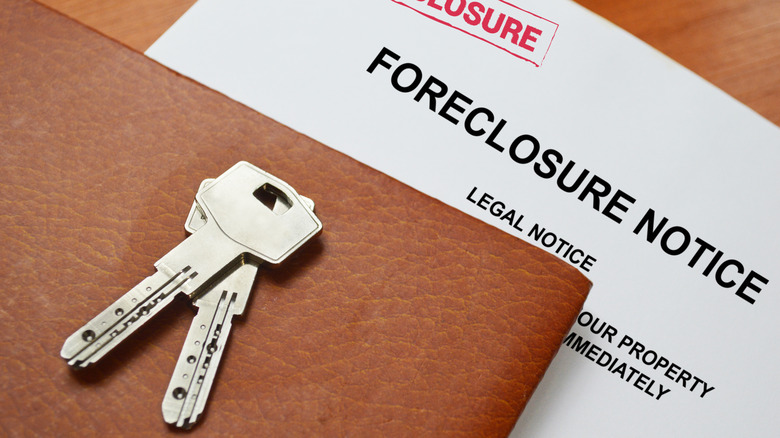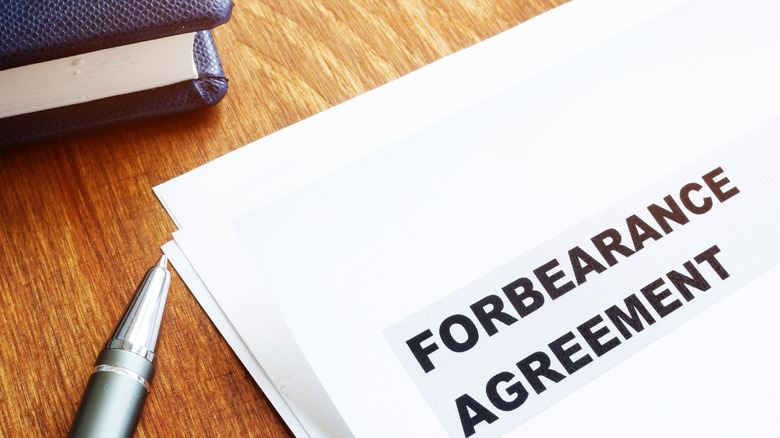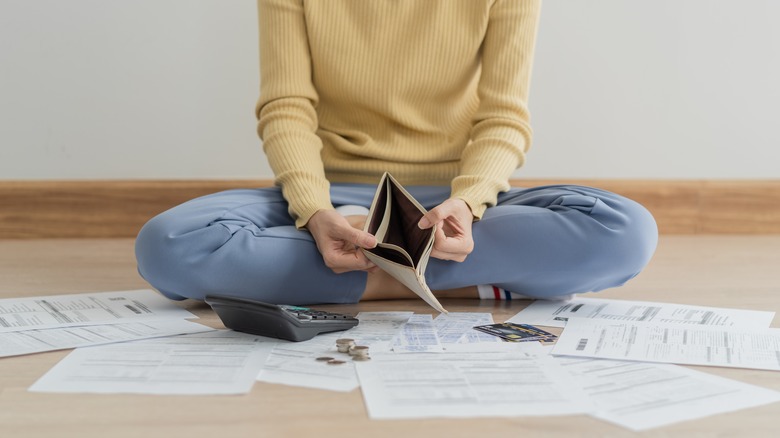Everything You Need To Know About Going Into Foreclosure
You may have heard the term tossed around in conversations about the absolute worst-case scenario that can result from home ownership: foreclosure. It sounds terrifying, but it probably seems a lot scarier because foreclosure is not very well understood. Of course, it is still a situation you want to avoid at all costs, but learning more about what goes into it and, more importantly, how you can avoid or avert it can help you feel better prepared to deal with a potential foreclosure situation as a homeowner or prospective homeowner.
Essentially, foreclosure is the legal process in which a mortgaged property becomes legally owned by the mortgage lender, as opposed to the mortgage borrower, Experian details. In most home purchasing scenarios, the homebuyer takes out a mortgage loan (unless they have the funds to buy the property using cash).
The mortgage lender, typically a bank, and the homebuyer agree on a payment schedule to pay back the loan. The homebuyer can then use the borrowed money to purchase the house, with the property serving as collateral in case the homebuyer stops making payments to the mortgage lender. Foreclosure involves the mortgage lender moving to possess the collateral property. It's a terrible situation for everyone involved, obviously for the homeowner losing their home, but also for the mortgage lender moving to possess the home, as that process can be extremely complicated and expensive.
How foreclosure is initiated
Don't worry; you can't find yourself in the foreclosure process completely out of the blue. Several things need to occur before anyone can start having conversations about moving into foreclosure, and Experian outlines all of the steps leading up to the initiation of the process.
First, the homeowner needs to miss a mortgage payment (and the late payment deadline, too). The mortgage lender will send a missed payment notice, warning that any future missed payments may begin foreclosure discussions. Mortgage contracts need to designate the number of missed payments that will trigger the foreclosure process, and the standard mortgage contract sets that number at two.
The mortgage lender will send a demand letter on the second missed payment. Investopedia defines a demand letter as the first step before official legal action. It is a formal documentation of a legal dispute (typically a failure to pay on a loan). A demand letter needs to outline the damage that has been done, what is needed to fix the damage (in this situation, paying back the missed payments and any associated late fees), the deadline for restitution, and what happens if the deadline isn't met.
On the third missed payment, the mortgage lender will hand over the loan management to their foreclosure department, and the homeowner will officially enter the reinstatement period. This means they have 30 days to make their missed payments, or their loan will be considered default.
The pre-foreclosure process
Once the reinstatement period ends and a homeowner officially defaults on their loan, the mortgage lender initiates the pre-foreclosure process, as explained by Investopedia. The mortgage lender kicks the pre-foreclosure process off by filing an official notice of default with a court if required by the state (different states have different required steps for foreclosure). The note of default is a public notice containing the homeowner's and mortgage lender's contact information (usually names and mailing addresses), the address of the property in question, and the nature of the default, i.e., how long it has been since the homeowner satisfied the payment terms of their loan.
The judge will then decide whether to grant the lender a lien, which is an official legal claim to the property used as collateral in the homeowner's loan. Once the mortgage lender has been granted the lien, the home is legally in foreclosure. That means it becomes the property of the mortgage lender, and the homeowner no longer has any legal rights to the house, meaning the mortgage lender can begin the process of eviction if the homeowner is still residing on the property.
What happens to a property in foreclosure?
For states such as Florida, Illinois, New York, and the 22 other areas that require the mortgage lender to follow the process outlined above (which is also referred to as judicial foreclosure, per Nolo), once the mortgage lender has adequately proven that the homeowner has not followed through on their payment commitments and the lender has been granted a lien on the property, the lender will likely attempt to sell the house.
This sale will probably take place at what is commonly known as a sheriff's auction or sheriff's sale. The Balance explains that a sheriff's auction, contrary to its name, is not necessarily an auction presided over by the local sheriff but rather a public auction to sell off all defaulted property, often at steeply discounted prices. The mortgage lender may participate in a sheriff's auction if they need to sell the house quickly to settle the defaulted loan balance. They may also choose to sell the property themselves through the traditional real estate market, which will take longer but may net them a larger profit (although foreclosed homes still typically sell for less than their market value).
All in all, the entire process of foreclosure, from start to finish, can be quite lengthy. The average time amount for a home to go into foreclosure is 857 days, per Attom. That's over two years! However, the process can vary a bit between states, with Hawaii averaging 3,068 days and Wyoming averaging 173.
Ways to avoid foreclosure
Obviously, no homeowner wants to find themselves in a foreclosure situation. And, lucky for them, mortgage lenders also hate foreclosure because, as mentioned above, the whole process is lengthy and expensive. That's why lenders are often willing to work with homeowners to determine foreclosure alternatives. Investopedia provides a good breakdown of ways these two parties can collaborate to avoid foreclosure.
Suppose you have a valid short-term financial situation impacting your ability to make mortgage payments, such as a medical emergency or a sudden job loss. In that case, the mortgage lender may grant you a forbearance. A forbearance is a plan to temporarily lower monthly payments or even suspend payments entirely for a certain time period. If forbearance isn't an option, homeowners may be able to work with their mortgage lenders on a short refinance.
For a short refinance, the mortgage lender will agree to forgive some of the homeowner's debt and will refinance the remaining debt into a new loan. This new loan will have an extremely high-interest rate and a lot of associated fees, so homeowners should avoid this situation if possible, but a short refinance is still much better than a foreclosure.
Finally, if the homeowner is over 62 years old and has owned the home for long enough that there is a significant amount of equity in the home, they may be able to take out a reverse mortgage on their property and use some of that money to prevent the foreclosure.
Ways to deal with foreclosure
Foreclosure is an unfortunate circumstance for a variety of reasons. Beyond a homeowner in foreclosure being forced to give up their home, this affair also has some significant long-term financial consequences. As Experian explains, a foreclosure appears on a homeowner's credit report fairly quickly (within a month or two), but it does not disappear soon — it stays on the report for seven years from the date of the first missed mortgage payment. As a result, having a foreclosure on your credit report can seriously impact your ability to secure a new home loan.
One way to deal with the negative credit consequences of this occurrence is to ensure the foreclosure is never officially recorded by signing over your property to your mortgage lender and keeping the process out of the courts. Of course, you will still lose your home, but you will hopefully preserve your good credit.
Another strategy recommended by Investopedia is to sell your home to a friend or investor before the foreclosure process starts and then lease your home back from them, meaning you can stay in your residence. If you sign a lease with an option to purchase clause, you may also repurchase your home as soon as your financial situation improves. But of course, the best way to deal with foreclosure is to not have to address it in the first place, meaning you should keep a close eye on your finances and never purchase a house you can't afford.





